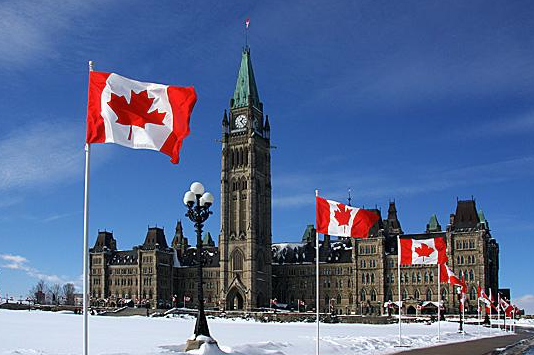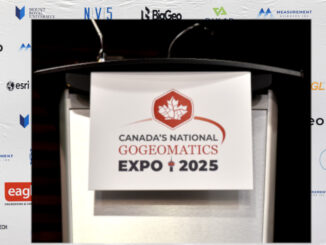
Editors note: This article has been jointly written by Bruce McCormack and Gordon Plunkett. Bios can be found at the bottom of the article.
Most people like to predict the future. People are interested in envisaging what new technology will be coming down the pipe, where their chosen career will take them, how will their health be as they age or will they be able to keep in good physical shape. For many people, their predictions of their future state are often exaggerated or just plain wrong. We live in a complex, fast changing world, so at the risk of being wrong, we have decided to make some predictions without exaggeration about the future applications of GIS in Canada.
While the focus is on Canada, some examples from Europe are provided. We will try and predict what GIS applications and technology will be used for in the next 5 to 10 years as opposed to how GIS will make use of new technologies like cloud computing, social media, data privacy and smart maps. Of course new technologies will impact GIS in Canada and elsewhere, but for this article we’ll focus on specific GIS business areas.
Governments 
The Canadian federal government, like most national governments, will continue to try and do more activities with less budget. This means the use of GIS will increase for applications such as asset tracking, policy development, monitoring policy implementation, and decision making across ever widening application areas. The federal government will work more closely with internal and external governments to share data, experiences, workflows and policies. Open government and open spatial data will continue to be supported, but the government will continue to struggle to keep open data sufficiently current so as to be useful. Because Canada is a vast country, the federal government will need to become more efficient at mapping the country and so further collaboration and cooperation within the federal departments will become the norm.
The provincial (and territorial) governments also need accurate and up-to-date spatial data of their geographic area in support of their provincial responsibilities. Open governments and open spatial data will also become best practices for provinces. Due to budget pressures, the provinces will look more to cooperation and collaboration internally as well as with other provinces on GIS infrastructure and workflows. A case in point is Ireland, where a financial crash in 2008, forced the government to efficiently use its resources, resulting in increased GIS use. Because Canadian provincial governments need GIS to support their business operations such as forestry, mining, agriculture, water, transportation, health, environment, etc., it will become more important.

Local governments are rapidly becoming leaders in GIS in Canada, mostly because they need to provide many geography-based services to their residents. These services include: public works, public safety, transit services, regional planning, property taxation and elections. Most municipal governments have large GIS departments which will continue to grow. Local governments perform their GIS data collection and maintenance independently. They also develop their own custom GIS applications and collect their own GIS data as there is generally no other government that they can work with to share GIS costs. All cities will move more toward the “smart city” model for which geography is a key element.
Businesses
Commercial businesses will continue to be major users of GIS applications. In the past, when you discussed GIS in Canadian business circles, people related it to Canadian Tire and Tim Horton’s use of GIS and demographics data for retail store locations planning. Retail siting applications are still growing, but there are a host of other “business” GIS applications that are just taking off.
Many businesses use spatial metrics for calculating or decision making in spread sheets or in the staff minds. Now GIS is being used resulting in less errors and higher ROI. For example, the use of GIS in the insurance business will continue to grow. Insurance companies need to know if your property is in a flood zone or if you frequently drive your car in a high accident risk area. GIS helps insurance companies map risk. 
In Europe, the European Umbrella Organization for Geographic Information (EUROGI) received funding from the European Commission for agriculture risk insurers. The work combined satellite, drone, in situ, weather models, social media and other data into risk calculations. This integration of diverse data sources was done using GIS. EUROGI are also involved in preparing a proposal for the European Commission covering emergency risk planning, scenario building and testing, with partners as fire departments, ambulance services and the police. Emergency response planning involves risk estimation, both of which depend on GIS.
Real estate will also grow in GIS use. Many real estate purchasers use the Internet to filter listings prior to viewing the property. Home buyers can filter by location of schools, shopping, transit and a host of other spatial information.
An innovative real estate example is a company in Europe which has the national address database for Ireland. They recently launched an application whereby users can point their smart phone at buildings and if the property has been recently sold the sale price will show up on their screen. Other data will be added to the app in due course. This is an example of augmented reality. Position is the key element which enables this to happen.
Marketing, communications and delivery companies will increasingly use GIS for improving decision making, increasing efficiencies and decreasing their operating costs.
Utilities
Utility applications are most dependent on infrastructure location. Government and privately owned utilities need to know where their assets are located, what the state of maintenance of the asset is and how to access the asset if there is a need. Also network analysis for outage detection and supply efficiency is run routinely. Information about the surroundings of a utility’s assets is very important in order to get the whole picture (situational awareness). 
Electric utilities will grow their use of GIS not just as a system of record for their assets, but sensors in the network will help operators detect issues more quickly and help them take corrective action immediately. While we won’t see a true “Smart Grid” in perhaps ten years, the utilities will be well on their way to providing better service for existing customers and growing the grid in a sustainable fashion.
Oil, gas and water utilities will be forced in approximately the next ten years to install a significant number of sensors in their pipeline network to look for flow anomalies because of leaks. A GIS would be able to monitor flows notifying an operator of problems. The utility could then send out a crew to the location to assess the issue. Also, these utilities could monitor neighborhood use and potentially improve the maintenance of their utility network.
These utility applications include sensors and linking them is an essential utility network component. The Internet of Things (IoT) is an emerging standard for sensors and actuators that would allow operators to remotely monitor and control what is happening within their network. Of course most of the monitoring and control capabilities would be useless unless the operator knew the exact location of the IoT devices. Thus GIS will become an integral part of the future more complicated and expensive smart utility networks that Canadians depend on.
While communications utilities will continue to be a strong business in Canada, it is unlikely that significant additional metal wire or cable will be installed. The communications industry will continue moving to optical fiber and wireless networks. GIS will be important for siting communication towers and routing optical fiber through the most cost effective locations. In wireless communications, the 5G network is coming that will be able to handle significant volumes of network traffic within a given geographic radius of the tower. This makes communication tower siting very important, but also opens the door to significant new application innovations using wireless communications technology and the IoT.
Other industries
While Defence is a federal government responsibility and is not as big a business in Canada as in other countries. It still is an important GIS application. As weapons such as tanks, aircraft, ships and carriers become smarter, most of the intelligence that is being built into these weapons has a geographic component. Moving vehicles need to know where they are in relation to the enemy and they need to provide drivers and operators with reliable spatial information. One of the newer technologies that would not work without geospatial data is the drone or Unmanned Aerial System (UAS). The use of drones in both the military and civilian markets will continue to grow significantly in the next 5 to 10 years.
Transportation is probably the biggest concern for people in urban centers. Major roadways are congested at peak hours. Accidents and bad drivers cause major congestion. Real-time GIS will help direct drivers around congested routes. GIS will help transportation planners plan more efficient networks and help route operators monitor and adjust traffic to improve flow.
Driverless / driver-assisted cars will likely be the norm in 10 years. While smart cars will help poor drivers to not create obstructions for other drivers. Smart cars require accurate route location information. This information is being collected. In the future, location data updates will be sent from smart cars to the various routing servers.
There are many applications that will benefit from the use of GIS in health care, agriculture, environment and public safety. It is hard to imagine activities in the future that will not be affected by GIS. Even the entertainment world is being turned on its head by the recent success of the Pokémon GO application which uses real-world geographic information.
Are you interested in reading more? The authors have written other articles recently regarding “the future of GIS”. These blogs look at the future of GIS and SDI from various perspectives. See:
So will we see a “GIS classic” application in 10 years? Will GIS as we know it today be a thing of the past? We don’t think so. GIS will continue to evolve as the diverse applications that need GIS data and technology grow.
Bruce McCormack:
Bruce is a qualified town and regional planner (M.Sc. (TRP) from the University of Natal, South Africa) who has over 40 years experience working as a planner in the public and private sectors in both South Africa and Ireland. For just over two years from 2010 Bruce was Senior Spatial Data Infrastructure Advisor to the World Bank, where the focus was on SDIs in South Korea, Brazil, Jordan and Uganda.
From 2011 until 2015 Bruce was the President of EUROGI, the European Umbrella Organisation for Geographic Information (www.eurogi.org). He had been President on a number of occasions over the past decade of the Irish Organisation for Geographic Information (www.irlogi.ie).





Be the first to comment